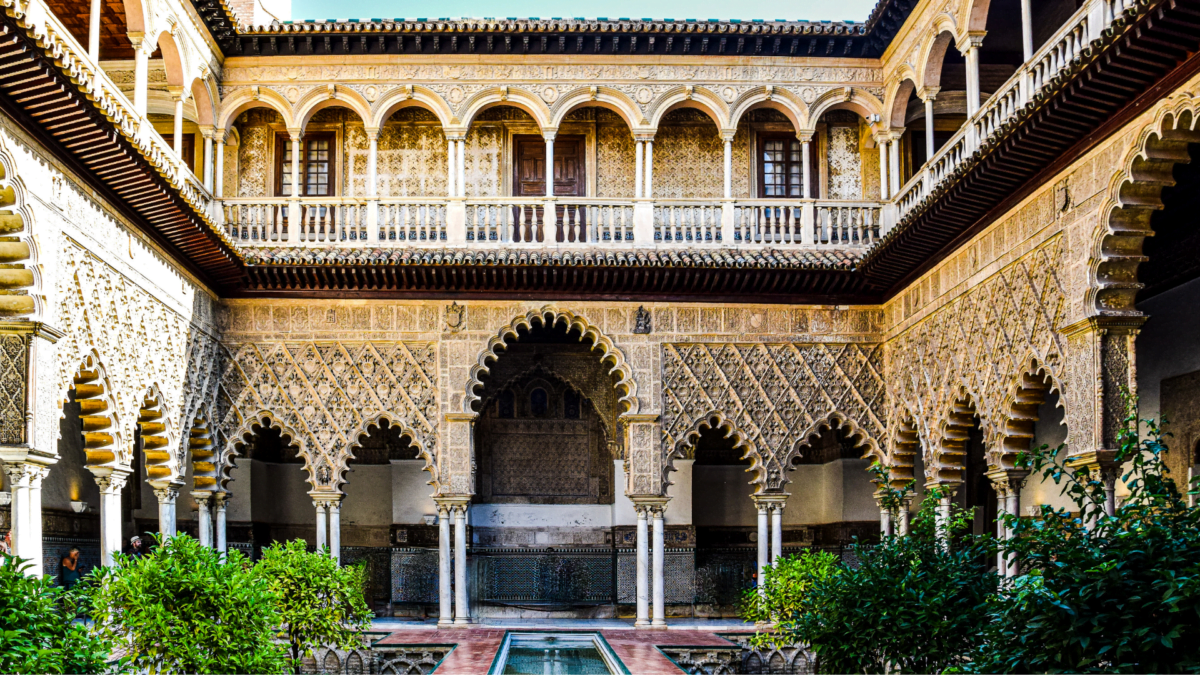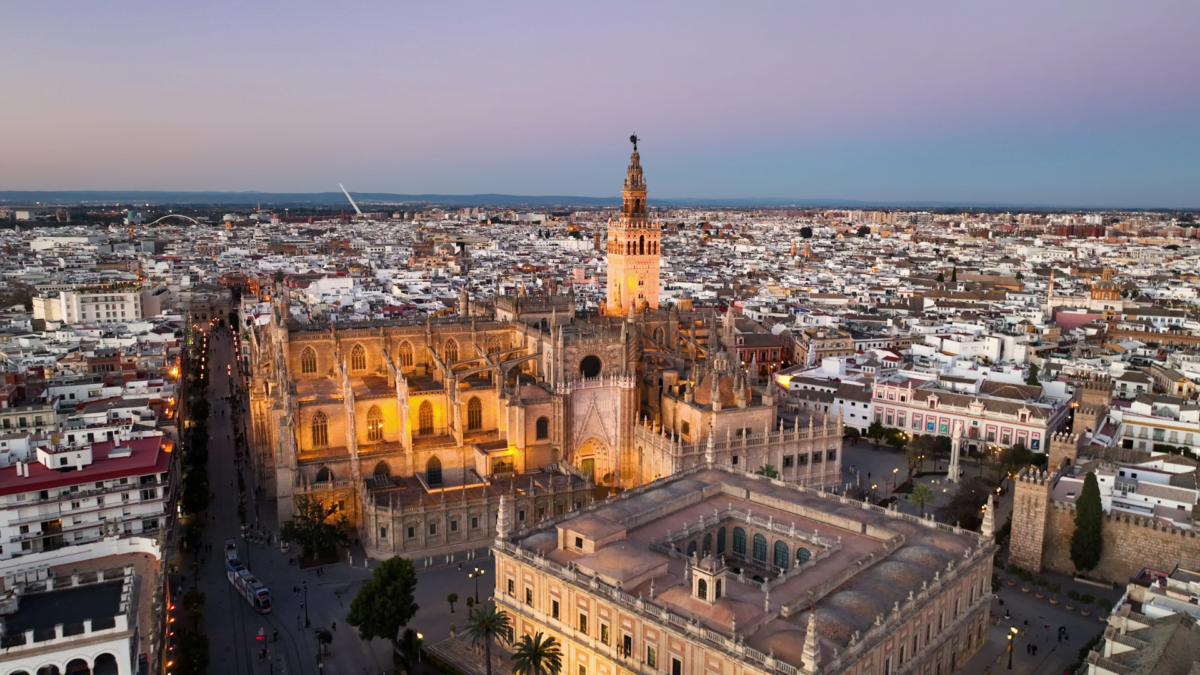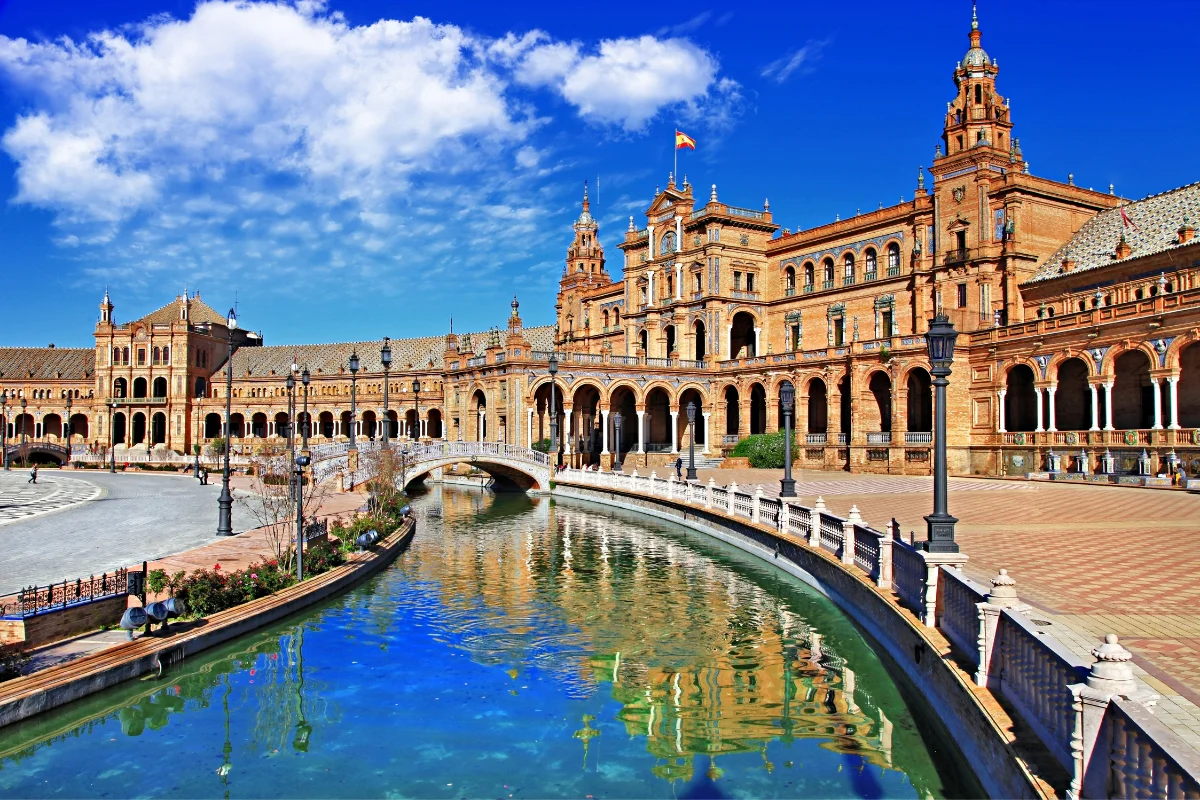In the south of Spain, Seville, the capital of Andalusia, certainly deserves a visit; it ranks as one of the finest cities in the country, and who knows – if not in Europe. Here you can stroll the streets full of bars and atmospheric restaurants and marvel at the gems of ancient architecture as well as bold contemporary designs.
This is what Seville is famous for
An absolute ‘must-see’ in Seville is the Plaza de España, or Spanish Square, which has formed the setting for many a film. Tourists fill it from morning until late in the evening. When taking photos here, it is difficult to capture everything: its size, the magnificent views or the architectural details.
The surrounding semi-circular canal adds to the charm. For a few euros, you can feel like you are in Venice and hire a rowing boat for 20 minutes to sail around the square. Horse-drawn carriages also await tourists. Around holidays and on special occasions, you are bound to come across churros stalls next to the entrance to the square. Another variety of fried sweet snacks is also popular here – these are tiny buñuelos doughnuts, which are said to be the best in Seville!
While in the area, do not forget to visit the Maria Luisa Park (Parque de María Luisa), considered the greenest space in Seville. The park covers an area of around 34 hectares and is located in the former gardens of San Telmo. It was in the palace complex that Princess Maria Luisa lived, and this is where the park got its name. Built for the Ibero-Americano World’s Fair in 1929, today it is surrounded by attractive monuments and museums and is on the list of must-see places for tourists from all over Europe.
The current shape of the park is the result of modernisations carried out since the 19th century. However, most of the elements of this green space in the heart of Seville are the result of preparations for the Ibero-Americano Fair in 1929. The reconstruction project was prepared by the famous French landscape architect Jean-Claude Nicolas Forestier. It is worth noting that this huge park can be explored in a variety of ways: by bicycle, boat and even…. by carriage. What sets the space apart from other green refuges in Seville are the so-called glorietas, or gazebos: Glorieta de Cervantes or Glorieta de Francisco Rodríguez Marín.

What else is there to see? Certainly one of the largest Gothic churches in the world – the Cathedral of the Blessed Virgin Mary (Catedral de Santa María de la Sede). Completed in the early 16th century, it was built on the site of… a deteriorating mosque. All that was left of the Muslim temple was the Patio de los Naranjos (now surrounded by cloisters) and the former minaret La Giralda, which in time became a symbol of Seville. Today it serves as a bell tower and an observation deck. You can enter the cathedral itself for a dozen euros.
The cathedral is a building whose interior and decoration remain in the memory of tourists for a long time. This is because it is one of the largest Gothic cathedrals in the world and the third largest, taking into account other architectural styles used in church building. It took more than 100 years for a structure of this size to be built! Work was initiated in 1401, starting with the removal of parts of the former mosque.
The city’s Muslim history is recalled by La Giralda tower, which once housed a minaret. A key feature of Seville’s cathedral is that inside is the tomb of America’s discoverer, Christopher Columbus. Why does his body rest here? Although he was Italian, it was through the Spanish authorities that he made his historic discoveries.

On the UNESCO list
If you are travelling through Spain on the trail of UNESCO-listed monuments, you are in the right place. It includes the aforementioned cathedral and bell tower, the nearby alcázar – which is a castle that dates back to the Caliphate and was taken over and transformed by the Catholic rulers. The Royal Palace, meanwhile, was modernised during the reign of Peter I the Cruel. The idea behind the then ruler was that, once rebuilt, the building would effectively rival the Alhambra with its splendour.
The entire construction process took more than 10 years, and leading architects and designers from the Old Continent were involved to achieve the final result. A place you should definitely visit is the Palacio Real. To this day, it is still one of the official residences of the King of Spain. When visiting the Royal Palace, do not forget to visit the courtyard of the virgins and the so-called Gothic Palace. What makes the alcazar particularly special on the tourist map of Seville are the gardens – covering more than 10 hectares, where it is estimated that there are several hundred plant species.
Also on the UNESCO World Heritage list is the Archives of India, created in the mid-18th century in the former stock exchange building. It was then that the most valuable artefacts and documents relating to Spain’s colonial conquests were gathered in one place. In total, the archive’s documentation is said to be some 9 km long and 80 million pages! Why is it located in Seville? It was here, in the halls of the royal alcázar, that Magellan’s voyages were decided and Columbus was received on his return from America.
The main Archive of the Indies – Archivo de Indias – is a UNESCO World Heritage Site. In the 16th century, the building was the stock exchange of Seville. At the end of the 18th century, its use was changed to the Main Archive of India. It was in this building that all the documents related to the Spanish colonies were located. It is therefore a treasure trove of knowledge about the history of Spain, the Old Continent, but above all the geographical discoveries that changed the face of our civilisation.

A bit of modernity
A respite from Seville’s old buildings will be a stroll through the Metropol Parasol, which houses market halls, restaurants, cafés and even a playground. The locals also call it Setas de Sevilla (Seville Mushrooms). Be sure to climb up to the viewing terrace! The construction took six years to complete and was finished in 2011. According to many experts, it is today one of the largest wooden structures in the world.

The attraction for tourists is the viewpoints – located at a height of 22-28 metres, from which it is possible to admire the panorama of Seville. An important hint for tourists – on the 1st floor of the Setas complex is the famous inscription ‘I love Sevilla’. In addition, in the basement you can see the famous ruins of Roman and Arab buildings, including Roman mosaics that have been preserved to this day.
Another building, built in a modern climate, is the Torre Sevilla – the first skyscraper in Andalusia and the tallest building in the city. Torre Sevilla has an interesting shape of a tapering ellipse. Inside, you can relax in the El Duente restaurant, which offers a panoramic view of the bustling city. On the menu, you will find typical Andalusian dishes with a modern, authentic twist.
Seville’s unique palaces
When in Seville, a visit to the Pilatos Palace – La Casa de Pilatos – should not be forgotten. But why such a mysterious name for this building? Namely, in the 16th century, this was the location of the first station of the Stations of the Cross, which began here during the solemn celebrations of Holy Week.
What attracts architecture lovers to Seville are the exceptional palaces. Start with the Palacio Marqueses de la Algaba, then head to the Palacio de los marqueses de Salinas and the Palacio de las Dueñas. Why it’s worth it. To experience the atmosphere of this part of Spain, the culture, architecture and history.

The Palacio de las Duenas is a unique building dating back to the turn of the 16th century. The building’s architecture blends Renaissance style with mudejar and Gothic influences. What also brings solace to visitors today are the extraordinary gardens with lush vegetation. The place is inextricably linked with the person of the famous Spanish poet Antonio Machado. According to legend, it was in the gardens here that he loved to spend time.
The Palacio de la Condesa de Lebrija is a palace built in the 16th century and is another example of the successful combination of Renaissance and Mudejar styles. It was remodelled at the beginning of the 20th century and many antique elements were introduced. When visiting the building, you can admire the huge collection of ancient Roman mosaics.
Feel the atmosphere in Seville
Spain has been famous for bullfighting for decades. Seville is home to one of the oldest arenas for this type of competition and can hold up to 12,000 spectators. It is particularly worth a visit as the venue houses the unique Corrida Museum.
A place worth recommending when visiting Seville is the Alameda de Hércules, which was built in the second half of the 16th century. It is a public garden that was still a meeting space for the upper classes in the 19th century. It is worth spending time here, especially in one of the restaurants or cafés, to better understand Spanish leisure culture.
Where to go for more entertainment? To Isla Magica, an amusement park that was established in 1997. A decade ago, it was expanded to include a section with water attractions – ideal for hot days on the Iberian Peninsula.
Off the beaten track
It is also worth discovering places that are not so popular with tourists. Then head to the Macarena district. It is here that you will find the old city walls, which still remember the Arab rule over the area. The walls are topped by a gate called the Arco de la Macarena. After passing through it, visitors can see the Basicila de la Macarena, a church of an unusually intense yellow colour. Inside, the statue of Our Lady of Hope, which is decorated with countless jewels, attracts attention. She is carried during the celebrations of Holy Week and thus walks the streets of Seville.
For a place full of urban bustle, head to Sierpes Street, a pedestrian street in the heart of Seville. It starts at the Plaza de la Campana and is crowned by the City Hall building. Unique townhouses are located on either side, and this place is bustling from dawn to dusk. The local town hall, known as the Ayuntamiento de Sevilla, is also worth a visit. The building is made up of two buildings that were built in completely different periods and different architectural styles.

What sets Seville apart from other Spanish cities is the mix of Christian and Muslim influences. The history and architecture here was influenced by the Carthaginians and Romans. The later leaders of the Empire – the Roman Emperor Hadrian and Trajan – were born here. However, the Moors, who ruled these lands, left the most traces of the past. They took control of Seville in 712 and ruled it for more than 500 years until the 13th century, when the area was once again recaptured by Christian armies.
These are just some of the reasons to visit Seville. The capital of Andalusia attracts you with its history, monuments and picturesque corners. This city simply has to be visited!

